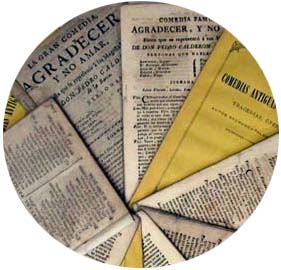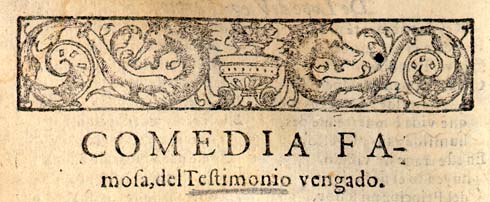| Please note that these pages are from our old (pre-2010) website; the presentation of these pages may now appear outdated and may not always comply with current accessibility guidelines. |
| Please note that these pages are from our old (pre-2010) website; the presentation of these pages may now appear outdated and may not always comply with current accessibility guidelines. |

| Unusually, this month we feature not just one book, but an entire collection of rare Spanish plays. Recently acquired by Glasgow University Library, the Scarfe-La Trobe collection is one of the most important additions to the Special Collections in recent years. It has been specifically selected to be highlighted this month to tie in with the annual Conference of the Association of Hispanists of Great Britain and Ireland, being held at the Kelvin Conference Centre here in Glasgow University. |
 Lope de Vega Carpio: El testimonio vengado1604 (Scarfe 739) |
|
|
The collection comprises nearly 2,000 items consisting of 1,068 plays (with 904 duplicates), ranging in date from the Seventeenth to the end of the Nineteenth Centuries. Representing a wide range of dramatic genres, a large proportion are comedias sueltas, that is, plays that were printed separately for sale in pamphlet form; a smaller number are desglosadas - plays printed to form part of (mainly) seventeenth century volumes; such volumes normally contained 12 plays, but they were also made available 'disbound' for sale as single items. Printing plays in this form had its beginnings in an early Spanish practice of producing works, usually for a relatively cheap market, in single quarto gatherings; these were called pliegos sueltos (loose gatherings), translated by some scholars as 'chap-books'. The form proved to be a convenient way of popularizing single short dramatic works. Many of the collection's sueltas are eighteenth century editions, but, like the desglosadas, are plays composed during the Golden Age of Spanish theatre. The earliest item in the collection is the 1604 Valladolid edition of El testimonio vengado by Lope de Vega, a desglosada.
|
|
|
|
|
|
|
| Shown here on the left is the opening of the 'loa' or dramatic prologue to Calderon's Fieras afemina amor; written for the birthday of the Queen mother, Mariana of Austria, Philip IV's widow and mother of Charles II, the original edition was probably printed in 1670 for those who attended the first performance. Considered to be one of the finest of Calderon's mythological plays, it concerns several of the labours of Hercules and his amorous enslavement by Iole. On the right is the beginning of Querer por solo querer by Antonio de Mendoza. Originally published in 1623, this play was written to celebrate another birthday - that of Queen Isabel de Borbón; it was first acted by the ladies (meninas) of the court. | |
|
The collection also includes important rare texts by
eighteenth and nineteenth century playwrights, of which one of the most
famous is Ramón de la Cruz - a satirical observer, in numerous one-act
comic plays known as sainetes, of Spanish society.
Of international importance, the Scarfe-La Trobe Collection of Spanish plays constitutes a rich corpus of primary evidence which not only illuminates the character and development of Spanish drama but also demonstrates the mutually influential relationship between the national theatre of Spain and drama as it was created, read, performed and printed throughout Europe during three impressively productive centuries. It must be regarded as a major new research resource which will be of considerable benefit both to the University and to scholarship at large. The collection richly complements the holdings of sueltas and desglosadas in Spain's National Library and major collections throughout the world. |
|
|
|
|
|
|
Comprising so many variant texts, this collection gives both theatre-historians and textual critics the means to compare different versions of the same drama and to decide why the different texts exist: whether the playwright concerned had himself produced more than one version; whether the original text had been altered by actors for performance - perhaps to suit their acting capacities or their public's preferences; or whether, perhaps, the printers, always concerned to save money on paper for instance, had made textual cuts and changes on their own account. |
|
Study of the individual copies also reveals how the plays have been used by readers over the years. Many of them show the signs of wear and tear resulting from close reading and careless handling; others are marked by annotation and comments; some have been bound together in idiosyncratic compilations, as in this copy of two plays by Agustin Moreto and Roman Montero & Francisco de Villegas, bearing the handwritten titles on the cover.
The editions in this collection can provide, too,
essential clues to resolve cases of disputed or confused authorship as
well as problems of dating and uncertainties about performance and
reception. The fact that a significant number were used, or were printed
from manuscripts used by specific theatre companies, while many have
wrappers on which the printers list titles of other plays being offered
for sale, makes this collection additionally important to a thorough
knowledge of Spain's theatre-history.
Moreover, the fact that the work of more than a hundred different
printers is represented in the plays offers invaluable evidence to
enable a better understanding of the history of printing in Spain and
the rest of Europe - a still undercultivated area of research. |
|
|
|
| The collection belonged to Bruno Scarfe, formerly of La Trobe University. Mr Scarfe, who has close family connections with the city and the University of Glasgow, had had offers to purchase the collection from Spain and the USA, but Glasgow University, where his father was for many years a Senior Lecturer in the French Department, was by far his preferred permanent location. For more than a year Ann Mackenzie, Ivy McClelland Research Professor of Spanish, and David Weston, Keeper of Special Collections, sought and eventually found ways and means of bringing this major collection to Glasgow. |
|
|
An application made to the National Fund for Acquisitions resulted in the award of a 50% grant (the largest available), while the additional funds needed to assist purchase were provided from within the University - from the Chancellor's Fund, the Friends of Glasgow University Library and the Faculty of Arts Library Discretionary Fund. A final award made from the Principal's Strategic Development Fund, allocated to assist researches on the collection, which matched an amount for the same purpose from a private source, resulted in Mr Scarfe's agreement that the plays should pass to the University. |
|
|
| Since the sale was confirmed Mr Scarfe has generously donated additional items to the University, including manuscript fragments of two extremely rare Spanish plays, one of which dates from the seventeenth century. Special Collections proposes to acquire, as its funds allow, other rare Spanish dramatic texts, which will enhance still further the collection. |
|
|
Mr Scarfe has been engaged in research for many years to compile an Analytical Research Catalogue of the entire collection. It is now his intention to complete this project at Glasgow University in collaboration with Professors Ann Mackenzie and Don Cruickshank, the results of which will be published both in print and online through the Bulletin of Spanish Studies, a Glasgow-based international research journal. |
|
The annual conference of the Association of Hispanists of Great Britain and Ireland is being held at the Kelvin Conference Centre 14-16 April 2003. Throughout the conference, a small display of Spanish material - spanning the fifteenth to the nineteenth centuries and drawing upon several collections - will be held in the Henry Heaney Room, Special Collections Department, Level 12, Glasgow University Library. Several examples of plays from the Scarfe-La Trobe collection will be included in the display. Opening times:
Monday 14 April:
10.00-17.00 |
Other items of interestOnce the cataloguing of the collection is complete, the records will be loaded into the main library catalogue, as well as appearing in the Bulletin of Spanish Studies. In the meantime, any researchers wishing to use the collection should consult a handlist (ordered alphabetically by title with an author index) available in the Special Collections Department. For an introduction and background to the printing of sueltas
and desglosadas see: |
|
The text of this article is based upon information supplied by Professor Ann L. Mackenzie Return to main Special Collections
Exhibition Page Julie Gardham April 2003
|